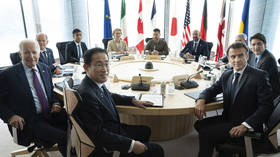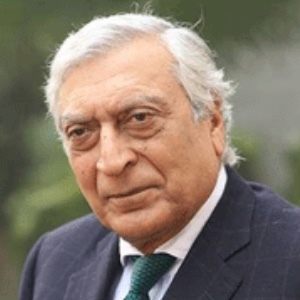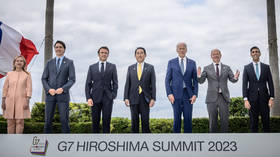The G7’s nuсlear-weapon-free world ‘vision’ is a farce

The choice of Hiroshima as the venue of May’s G7 meeting implied that the issue of nuclear disarmament would be highlighted in the summit documents. Not surprisingly, the G7 leaders issued the “Hiroshima Vision on Nuclear Disarmament” to mark the occasion.
It was essentially a ritualistic exercise to cater to Japan’s special sensitivities on the nuclear issue as the only country ever subjected to a nuclear attack. Not highlighting the nuclear disarmament issue would not have been possible morally, and politically too as Hiroshima is part of Japanese Prime Minister Kishida’s constituency.
What was not possible was to give life to something that is virtually moribund. Hence, the vision statement is not an entirely honest document. It is politically self-serving, distorts the realities on the ground and contains much posturing.
The document begins by acknowledging that Hiroshima is a reminder of the “unprecedented devastation and immense sufferings of the people of Hiroshima and Nagasaki experienced as a result of 1945 atomic bombings.” However, it neither condemns the use of nuclear weapons nor says who was responsible. Understandably so since the document is issued in the name of the US among others.
The signatories speak of their commitment to “achieving a world without nuclear weapons with undiminished security for all.” The thought behind such an assertion is not clear. Nuclear weapons are seen by those possessing them as ultimate providers of security against existential threats. If they are eliminated, how would the concept of “undiminished security for all” operate? Will it be through a deterrent balance in conventional arms, which means more advanced conventional weaponry and more defense allocations? Who are the “all” it speaks of – obviously not the non-nuclear-armed countries?
The concept of “undiminished security” and the related concept of “equal and indivisible security” has not worked in geographies hitherto central to these concepts. It has not worked in Europe. If it had, the world would not be seeing the present conflict in Europe over Ukraine in which nuclear powers are pitted against each other, with unpredictable consequences.
The document berates as “dangerous and irresponsible” Russia’s “nuclear rhetoric, undermining of arms control regimes, and stated intent to deploy nuclear weapons in Belarus.” But in fact, it is the US that abrogated the Anti-Ballistic Missile (ABM) Treaty with Russia in 2002, in the belief that it could develop an impenetrable ballistic missile defense. Leaving aside the polemics around it, it is the US again that in 2019 withdrew from the INF Treaty. Trump while in office was even hinting that he would not renew the New START Treaty. Now with both Russia and the US suspending the operation of this treaty and associated inspections in the wake of the Ukraine conflict, its future has become uncertain. Denouncing Russia’s intention to deploy nuclear weapons in Belarus raises the question about the existing deployment of US tactical nuclear weapons in six bases in five NATO countries: Belgium, Germany, Italy, the Netherlands, and Türkiye.
If Russia has reminded NATO of its nuclear deterrent in the context of a potential escalation by NATO in the Ukraine conflict with the goal of Russia’s strategic defeat, the US too has often mentioned that all options were on the table to prevent Iran from going nuclear, leaving it unsaid what “all options” really meant.
In any case, the very fact of possessing nuclear weapons implies the potential of their use if deterrence fails. If they are not meant to be used in any circumstances, then why have them? The US nuclear doctrine has so far not accepted the “no first use policy,” despite non-nuclear countries advocating this as a first step to reduce the nuclear threat to humanity.
The G7 vision document says that the “overall decline in global nuclear arsenals achieved since the end of the Cold War must continue and not be reversed.” But what about modernisation of existing arsenals and pursuit of more advanced nuclear weaponry within the agreed limits under the New START Treaty? In 2010, former US President Barack Obama authorized a nuclear modernisation programme that would cost $1 trillion over the next 30 years. It called for a slew of new cruise missiles, ICBMs, nuclear submarines, and long-range bombers over the next three decades. The US Congressional Budget Office estimated in May 2021 that the US would spend $634 billion over the next 10 years to sustain and modernize its nuclear arsenal.
In the document the G7 members reaffirm their “commitment to the ultimate goal of a world without nuclear weapons with undiminished security for all, achieved through a realistic, pragmatic and responsible approach.” This is posturing, given the caveats attached to this commitment. How is “realistic, pragmatic and responsible” defined? The signatories have given themselves all the leeway they need to make a noble-sounding statement without committing themselves to any foreseeable timeline or accountability.
To speak of “the immediate commencement of long overdue negotiations of a treaty banning the production of fissile material for use in nuclear weapons or other nuclear explosive devices,” is an empty bow to Japan which makes it a point to include this in all possible documents it signs. For 30 years, there has been no progress on this issue. The US, which pushed this treaty initially, no longer pursues it. Urging “all countries to refocus political attention towards the FMCT” (the proposed Fissile Material Cut-off Treaty) is simply playing to the gallery.
Similarly, the Comprehensive Nuclear-Test-Ban Treaty (CTBT) went into limbo long ago. Adopted by the UN General Assembly in 1996, it is still not ratified by eight nations, including the US. Nuclear-armed countries have clearly lost interest in it, and they have carved out space for themselves to conduct non-explosive tests to design and develop new and more powerful weapons. This is demonstrated when they say in the G7’s ‘Hiroshima Vision’, that “We are resolute in our view that no nation should carry out any nuclear weapon test explosion or other nuclear explosion… We remain committed to upholding the global norm against nuclear explosive testing.” Russia has declared that it will conduct nuclear tests if others do, meaning not unilaterally, and this caveat is ignored in the G7 text.
It is not evident how effective the G7’s “unwavering commitment to the goal of North Korea’s complete, verifiable, and irreversible abandonment of its nuclear weapons and existing nuclear programs” will be, given that North Korea has repudiated the Non-Proliferation Treaty (NPT) and is conducting nuclear tests – the only country to do so.
The G7 expresses deep concern about “Iran’s unabated escalation of its nuclear program, which has no credible civilian justification and brings it dangerously close to actual weapon-related activities.” This is a development resulting from a signal failure of US diplomacy in repudiating the JCPOA (the Iran nuclear deal) in May 2018. To say that “A diplomatic solution remains the best way to resolve international concerns regarding Iran’s nuclear program” is therefore extremely ironic. In any case, the latest geopolitical developments triggered by the Ukraine conflict and the growing US-China confrontation would make it difficult to develop a consensus either amongst the P5+1 nations or in the UN to address the Iranian nuclear issue.
Meanwhile, Germany is opting out of nuclear power which explains why the G7 mentions that “Those G7 countries which opt for nuclear power… recognise that the use of nuclear energy, science, and technology contributes to providing affordable low-carbon energy.”
It is cynical to say that “Achieving the world we hope to see requires a global effort to take us from the harsh reality to the ideal, no matter how narrow the path may be,” since the prime responsibility for a nuclear-weapon-free world lies on the shoulders of the P5 – the permanent members of the UN Security Council, that is the US, the UK, Russia, China and France – which still have either sizeable inventories of nuclear weapons or are expanding them, not to mention declared programmes to modernize them.
The statements, views and opinions expressed in this column are solely those of the author and do not necessarily represent those of RT.















